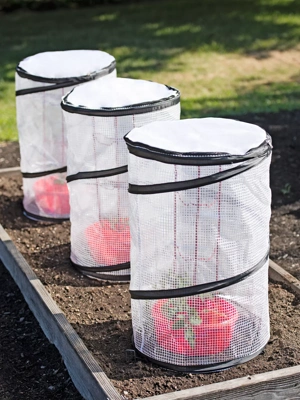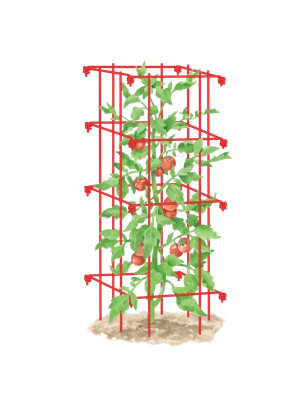Tomatoes
 Tomato varieties (left to right:) Black Cherry, Paul Robeson, (unkown) white tomato, German Stripe from the garden of one of our employee-owners.
Tomato varieties (left to right:) Black Cherry, Paul Robeson, (unkown) white tomato, German Stripe from the garden of one of our employee-owners.Tomatoes are the royalty of the garden — and the kitchen. They're the country's most popular garden vegetable by a mile. This is probably because it's almost impossible to duplicate the juicy sweetness of a homegrown tomato.
Tomato plants can be grouped into two categories:
- Determinate varieties grow to a moderate height, produce a lot of fruit, and call it quits.
- Indeterminate varieties grow tall and keep on growing and producing tomatoes until they're killed by frost or disease.
Starting Tomatoes from Seed
Tomato plants are easy to start from seed. Start them indoors, six to eight weeks before you put them out into the garden. Under warm conditions indoors (70 degrees F.), the seeds will usually germinate in just a few days. Provide your tomato seedlings with 15 hours of bright light each day to keep them from getting leggy. You may need to transplant them into larger pots if they grow very quickly. Tomatoes are hungry plants and they need to be fertilized frequently, starting as seedlings.

Heirloom or Hybrid?
Because of the huge number of tomato plants out there, it's difficult to choose what to grow. If you're growing in less space, consider a dwarf variety. If you have more room, the options are incredible.
- Heirloom tomatoes are all the rage for their rich flavors, diverse colors and interesting shapes. They are not usually as productive as modern hybrids, and they tend to be a little fussier about growing conditions. That said, the flavors, shapes and colors are unrivaled.
- Hybrid tomato varieties are tasty, reliable and productive. They have also been bred for resistance to a number of common tomato diseases. Unfortunately, you may find that even these disease-resistant varieties succumb to some of the same diseases that plague heirlooms. Most are fungal diseases that get established in the soil. It helps somewhat to mulch around your plants, and also to avoid growing tomatoes in the same place every year.
Support Matters
Always provide some sort of support for your tomatoes. Letting them flop on the ground increases disease problems. Get your supports in place at planting time and make a habit of checking weekly to tie, prune or tuck-in wayward branches.
Last updated: 01/29/2021
Print this Article:
Related items
Get the Dirt
Stay up to date on new articles and advice. Please fill out the information below.







